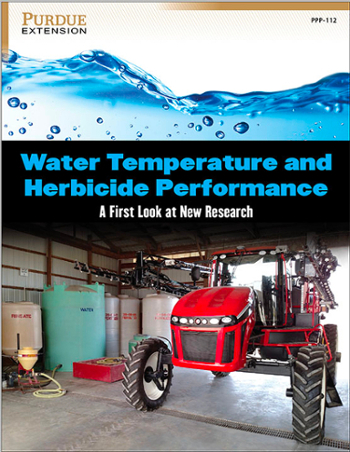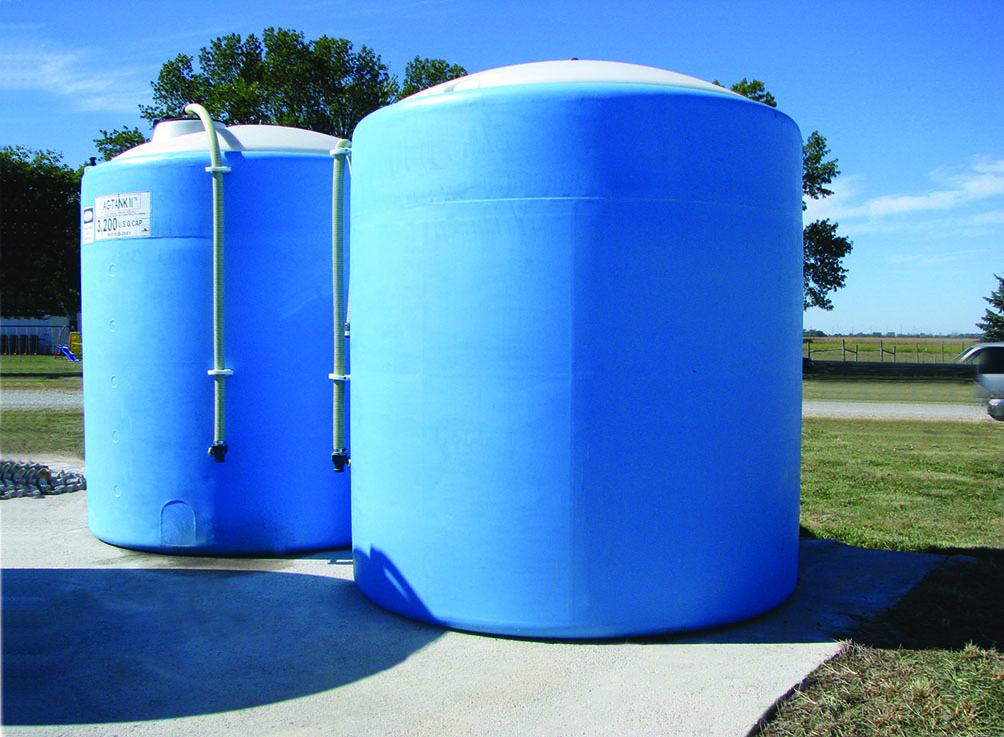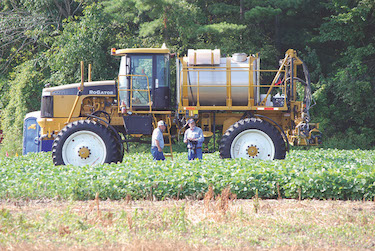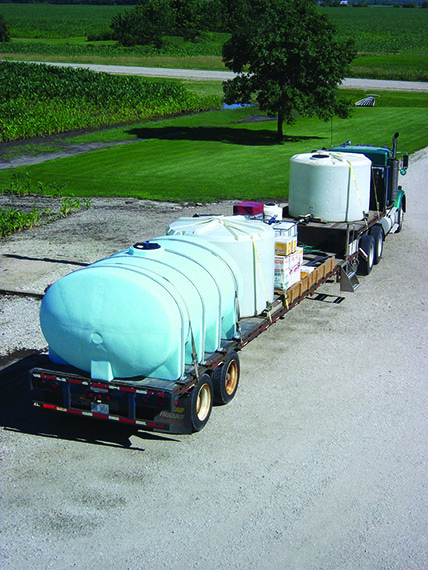Water Temperature and Herbicide Performance, a first look at New Research

Understand how cold water influences efficacy.
Authors
Pratap Devkota, Graduate Assistant in Weed Science, Purdue University
Fred Whitford, Director, Purdue Pesticide Programs
Bill Johnson, Professor of Weed Science, Purdue University
Bryan Young, Associate Professor of Weed Science, Purdue University
Travis Legleiter, Weed Science Professional Assistant, Purdue University
What you will find in this publication:
Water Quality ConsiderationsWater Temperature
What the Research Shows
Conclusions
Acknowledgements
Water Quality Considerations

The first step to ensuring an effective herbicide application is measuring the right amount of herbicide product. You need to know the difference between a liquid ounce and dry ounce, whether to use a scale or specialized volumetric measuring container to accurately measure products, and make sure the spray tank is properly marked. All these things are part of ensuring the highest level of weed control from any product. And farmers and commercial retail applicators understand that the water they use to mix and apply herbicides can influence weed control. Water makes up the majoity of herbicide spray solutions, so knowing the hardness and pH of the water can help improve the performance of some herbicides.
And you know that water from different sources can vary in the amount of dissolved minerals such as calcium and magnessium (referred to as water hardness), water alkalinity and acidity (water pH), and suspended/dissolved solid particles (water turbidity). A simple visual inspection of the water won’t determine if it will be good for mixing herbicides. Some assume that if the water is good for bathing, cooking, or washing, then it’s good enough for spraying; however, that’s not necessarily true. You can’t determine the pH or hardness of water by its appearance. Even water from different nearby wells can vary in their chemcial and physical properties.
Reading the herbicide label will tell whether you need to add an adjuvant to help the product overcome some of the physical and chemical properties of water. In some cases, the label will require a surfactant to help spread the water droplet over the leaf, or an oil to help the herbicide to penetrate through the waxy cuticle of the leaf. Not adding the adjuvants to optimize the foliar activity of your herbicide may result in poor or inconsistent weed control.
As we’ve described, there are many factors that can ultimately influence how well a foliar-applied herbicide product works.
Water Temperature
Farmers and applicators often ask whether the temperature of the mixing water influences herbicide product performance.
Water collected from surface sources (such as lakes and ponds) and groundwater are commonly stored in poly-tanks for hours or even several days before applicators pump it into spray tanks to mix with herbicides. In the United States, groundwater temperature typically ranges from 37°F in northern states to 72°F in southern states — Indiana usually ranges from 52°F (in the north) to 57°F (in the south).
When you pump underground water and store it in a tank, its temperature will adjust over time to the air temperature. How quickly the water temperature changes can be influenced by the tank’s material (poly, fiber, steel), color (light or dark), size, and location (indoor or outdoor).
But the question of whether water tempearture affects herbicide product efficacy and performance is difficult to answer, because little data exists. Actually, it’s surprising that there hasn’t been more research on water temperature’s influence in weed control, because temperatures in the spring and fall can be very cold relative to the same water stored in an aboveground tank in the middle of summer.
The authors conducted a research project that monitored the temperature in black and white poly-tanks filled with water throughout the year. We recorded how the water temperature in the tank changes with ambient air temperatures. In the spring (March to April) and fall (October and November) the water temperature in the poly-tank averaged below 40°F.
In the summer, water temperatures commonly reached 100°F. We also found that only a few degrees separated the water stored in black poly-tanks and white poly-tanks.
This research clearly demonstrates the extreme range in temperature for the water that may serve as the source for our herbicide applications (it also shows that the tank color’s effect is relatively insignificant).



What the Research Show
 Bad weather can halt herbicide applications for several days. That leaves previously mixed herbicides in the spray tank until field conditions improve. When this happens, does leaving the herbicide in cold, moderate, warm, or hot water for an extended time translate into poor weed control? The water in the tank will reach temperatures that correspond to air temperatures: lower in spring and fall, higher in summer.
Bad weather can halt herbicide applications for several days. That leaves previously mixed herbicides in the spray tank until field conditions improve. When this happens, does leaving the herbicide in cold, moderate, warm, or hot water for an extended time translate into poor weed control? The water in the tank will reach temperatures that correspond to air temperatures: lower in spring and fall, higher in summer.
In a greenhouse study, we tested whether water temperature and the time a spray solution sat in the tank influenced postemergence herbicide applications. We examined several weed species, including giant ragweed, horseweed (marestail), Palmer amaranth, and pitted morning glory. The water source we used was free of hard water cations or suspended particles, and the water had a pH of 6.8 (about neutral). We mixed postemergence herbicides into cold (41°F), moderate (72°F), warm (102°F), and hot (133°F) water. And we held each of these spray solutions before applying them for 24 hours, 6 hours, or 0 hours (that is, sprayed immediately). We used 2,4-D choline, glufosinate (Liberty®), mesotrione (Callisto®), and a premix of glyphosate plus dicamba.
 In our tests, the herbicide mixtures (spray solutions) that were held for up to 24 hours did not affect weed control with any of the tested herbicide products. However, it is important not to generalize these results for all herbicides. For example, research shows some herbicide products from group #2 (ALS inhibitors) can undergo hydrolysis when spray solutions remain in the tank for a certain period. Likewise, herbicides from group #1 (ACCase inhibitors) can break down when UV radiation infiltrates the tank.
In our tests, the herbicide mixtures (spray solutions) that were held for up to 24 hours did not affect weed control with any of the tested herbicide products. However, it is important not to generalize these results for all herbicides. For example, research shows some herbicide products from group #2 (ALS inhibitors) can undergo hydrolysis when spray solutions remain in the tank for a certain period. Likewise, herbicides from group #1 (ACCase inhibitors) can break down when UV radiation infiltrates the tank.
While the greenhouse study found that storage time did not influence herbicide efficacy, water temperature did appear to influence the response in some weeds and with some herbicides.
In other words, these studies showed that water temperature influenced herbicide performance. The table at the bottom of this page summarizes our research findings.

Acknowledgments
We would like to extend sincere thanks to the Indiana Soybean Alliance for funding the research that supported the development of this publication.
Find Out More
Purdue Pesticide Programs offer a number of publications on related topics to help you manage your operations better. All publications are available from The Purdue Extension Education Store, (765) 494-6749
 The Impact of Water Quality on Pesticide Performance (PPP-86). Understand how your mixing water influences pesticides.
The Impact of Water Quality on Pesticide Performance (PPP-86). Understand how your mixing water influences pesticides.  Measuring Pesticides: Overlooked Steps to Getting the Correct Rate (PPP-96). Understand effective measuring techniques that ensure success.
Measuring Pesticides: Overlooked Steps to Getting the Correct Rate (PPP-96). Understand effective measuring techniques that ensure success.  Adjuvants and the Power of the Spray Droplet (PPP-107). Understand how adjuvants can improve pesticide effectiveness.
Adjuvants and the Power of the Spray Droplet (PPP-107). Understand how adjuvants can improve pesticide effectiveness. June 2016/REV 2020
Order or download materials from
Purdue Extension • The Education Store

